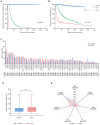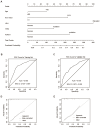Characteristics and predictive model for diffuse large B-cell lymphoma with early chemoimmunotherapy failure
- PMID: 40589747
- PMCID: PMC12206878
- DOI: 10.3389/fimmu.2025.1553850
Characteristics and predictive model for diffuse large B-cell lymphoma with early chemoimmunotherapy failure
Abstract
Introduction: The outcomes of refractory or relapsed diffuse large B-cell lymphoma are generally poor, especially those relapsed or progressed within 12 months from diagnosis named as early chemoimmunotherapy failure (ECF), with a 2-year OS of 24.7%. Due to the dismal outcome, early recognition of ECF and developing targeted innovative treatments to improve patient prognosis are urgent.
Methods: This study recruited 2038 newly diagnosed DLBCL patients treated with R-CHOP/RminiCHOP or R-CHOP-based immunochemotherapy in Ruijin hospital and 411 hospital from December 1997 to December 2020.
Results: Compared to the control group, ECF patients were significantly associated with elderly age, advanced Ann Arbor stage, elevated serum LDH, poor performance status, multiple extranodal involvements, double expressor lymphoma (DEL), and non-GCB subtype, as well as high frequencies of TP53, FOXO1 and FBXW7 mutations. Through multivariate analysis, elderly age, advanced stage, elevated serum LDH, DEL, and mutations of TP53 or FOXO1 were independent predictors of ECF.
Discussion: Based on these predictors, a nomogram of ECF was established, and the straining cohort of our Chinese patients as well as the external cohort from Western countries showed a good predictive power of the ECF model, indicating the efficiency of our ECF predicting model, regardless of patients' race. Our ECF model allows clinicians to early recognize ECF patients, to optimize the therapeutic strategies and to improve the outcome of those chemo-resistant patients.
Keywords: CAR- T cells; DLBCL - diffuse large B cell lymphoma; RCHOP-like regimen; chemo-resistant; early chemoimmunotherapy failure; nomogram.
Copyright © 2025 Dong, Shi, Wu, Zhao, Fu, Xu, Cheng, Bousquet, Zhao and Wang.
Conflict of interest statement
The authors declare that the research was conducted in the absence of any commercial or financial relationships that could be construed as a potential conflict of interest.
Figures




Similar articles
-
Treating newly diagnosed Diffuse Large B-cell Lymphoma in the elderly patient with R-mini-CHOP: A single centre analytical retrospective observational study.Med J Malaysia. 2025 May;80(3):307-312. Med J Malaysia. 2025. PMID: 40437719
-
The efficacy and safety of ZR2 versus R-CHOP-like for elderly patients with newly diagnosed diffuse large B cell lymphoma: a single-center prospective study in China.Ann Hematol. 2025 Jan;104(1):605-615. doi: 10.1007/s00277-024-06066-3. Epub 2024 Oct 30. Ann Hematol. 2025. PMID: 39472318 Free PMC article. Clinical Trial.
-
Favorable impact of zanubrutinib combined with R-CHOP regimen in MYD88-mutated new-diagnosed diffuse large B-cell lymphoma: a retrospective study with propensity score-matched analysis.Cancer Immunol Immunother. 2025 Jul 5;74(8):259. doi: 10.1007/s00262-025-04090-4. Cancer Immunol Immunother. 2025. PMID: 40616640 Free PMC article.
-
Rituximab (MabThera) for aggressive non-Hodgkin's lymphoma: systematic review and economic evaluation.Health Technol Assess. 2004 Sep;8(37):iii, ix-xi, 1-82. doi: 10.3310/hta8370. Health Technol Assess. 2004. PMID: 15361313
-
Chimeric antigen receptor (CAR) T-cell therapy for people with relapsed or refractory diffuse large B-cell lymphoma.Cochrane Database Syst Rev. 2021 Sep 13;9(9):CD013365. doi: 10.1002/14651858.CD013365.pub2. Cochrane Database Syst Rev. 2021. PMID: 34515338 Free PMC article.
References
-
- Coiffier B, Thieblemont C, Van Den Neste E, Lepeu G, Plantier I, Castaigne S, et al. Long-term outcome of patients in the LNH-98.5 trial, the first randomized study comparing rituximab-CHOP to standard CHOP chemotherapy in DLBCL patients: a study by the Groupe d’Etudes des Lymphomes de l’Adulte. Blood J Am Soc Hematol. (2010) 116:2040–5. doi: 10.1182/blood-2010-03-276246 - DOI - PMC - PubMed
-
- Harrysson S, Eloranta S, Ekberg S, Enblad G, Jerkeman M, Wahlin BE, et al. Incidence of relapsed/refractory diffuse large B-cell lymphoma (DLBCL) including CNS relapse in a population-based cohort of 4243 patients in Sweden. Blood Cancer J. (2021) 11:9. doi: 10.1182/blood-2019-122014 - DOI - PMC - PubMed
MeSH terms
Substances
LinkOut - more resources
Full Text Sources
Research Materials
Miscellaneous

